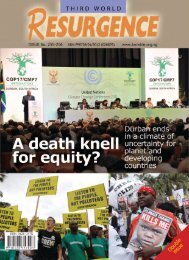Plantations, poverty and power - Critical Information Collective
Plantations, poverty and power - Critical Information Collective
Plantations, poverty and power - Critical Information Collective
Create successful ePaper yourself
Turn your PDF publications into a flip-book with our unique Google optimized e-Paper software.
61<br />
experimental areas <strong>and</strong> not from the company’s actual tree plantations. 299 A 2001 report by consulting<br />
firm AMEC found that average annual growth rates were 28 cubic metres per hectare on mineral soils <strong>and</strong><br />
23 cubic metres per hectare on peat soils. About 70 per cent of APP’s plantations are on peat soils. 300 In<br />
its 2004 Sustainability Action Plan, APP revised its annual growth rates downward to 23.2 cubic metres<br />
per hectare on mineral soils <strong>and</strong> 19.6 cubic metres per hectare on peat soils.301<br />
By 2001, according to AMEC, Arara Abadi, had converted about 217,000 hectares to industrial tree<br />
plantations. Of this, about half was forested, although AMEC acknowledges that this is little more than a<br />
guess. 302 Arara Abadi also has licenses to log a further 290,000 hectares of forest <strong>and</strong> convert it to<br />
plantations up to 2011. 303 AMEC bl<strong>and</strong>ly states that “there will need to be careful consideration of the<br />
international market acceptability” of clearcutting this forest <strong>and</strong> replacing it with monoculture tree<br />
plantations.<br />
“Several billion tonnes of carbon”<br />
Arara Abadi has caused irreparable damage to large areas of Riau’s swamp forest by cutting canals <strong>and</strong><br />
draining the swamp. The Kampar peninsula is the latest target to meet APP’s voracious appetite for<br />
timber. Covered in 400,000 hectares of peat swamp forest, the Kampar peninsula is the world’s second<br />
largest tropical peat swamp. It is an important habitat for the Sumatran tiger. 304 In 2004, WWF estimated<br />
the population of Sumatran tigers at less than 500. 305 Three years ago, APP announced its plans to<br />
clearcut 180,000 hectares of forest on peatl<strong>and</strong>s. 306<br />
“Until five years ago,” reports Fred Pearce in New Scientist, “Kampar was a true bog with water at the<br />
surface, <strong>and</strong> it was covered by a rich rainforest in which Sumatran tigers roamed. A huge dome of peat,<br />
up to 15 metres deep, had built up over the past 6000 years as woody debris fell into the swamp. It<br />
contains several billion tonnes of carbon.” 307<br />
299 Mats Valentin <strong>and</strong> Kristina Bjurling (2004) “Swedish involvement in the Indonesian paper <strong>and</strong> pulp industry”,<br />
SwedWatch, October 2004, page 13.<br />
300 Christopher Barr (2004) “Risk Analysis <strong>and</strong> Impact Assessment for Pulp <strong>and</strong> Plantation Investments: The Case of<br />
Indonesia”, presentation at International Forum on Finance <strong>and</strong> Investment in China’s Forestry Sector, Center for<br />
International Forestry Research (CIFOR), Beijing, 22-23 September 2004.<br />
301 Chris Barr (2008) “Indonesia’s Pulp & Paper Industry: Overview of Risks <strong>and</strong> Opportunities”, presentation at<br />
Roundtable on Indonesia’s Pulp <strong>and</strong> Paper Industry, New York, 10 April 2008.<br />
http://www.environmentalpaper.org/documents/Chris%20Barr%20-%20CIFOR.pdf<br />
302 “APP Pulp Mills & Sinar Mas Group Forest Companies Preliminary Sustainable Wood Supply Assessment<br />
Executive Summary”, AMEC Simons Forest Industry Consulting with Asia Pacific Systems Engineering, 21 November<br />
2001, page 4.<br />
303 “APP Pulp Mills & Sinar Mas Group Forest Companies Preliminary Sustainable Wood Supply Assessment<br />
Executive Summary”, AMEC Simons Forest Industry Consulting with Asia Pacific Systems Engineering, 21 November<br />
2001, page 4.<br />
304 “Asia Pulp & Paper (APP) Hiding Destruction Behind False Advertisements: APP continues to ignore calls for<br />
conservation beyond ‘legal compliance’, <strong>and</strong> even fails on the latter”, WWF Monitoring Brief October 2006.<br />
http://www.wwf.or.id/index.phpfuseaction=newsroom.detail&id=NWS1161151678&language=e<br />
305 “Sumatran Tiger on Brink of Extinction”, WWF Press Release, 16 March 2004.<br />
http://worldwildlife.org/news/displayPR.cfmprID=64<br />
306 Romain Pirard <strong>and</strong> Rofikoh Rokhim (2006) “Asia Pulp & Paper Indonesia: The business rationale that led to forest<br />
degradation <strong>and</strong> financial collapse ”, CIFOR, Working Paper No. 33, page 11.<br />
http://www.robinwood.de/german/trowa/sumatra/appcifor2006.pdf<br />
307 Fred Pearce (2007) “Bog barons: Indonesia’s carbon catastrophe”, New Scientist, 1 December 2007.















